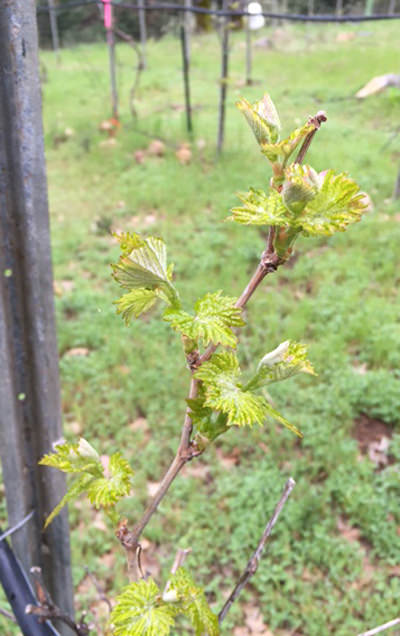I often find myself wishing I could wake up like a grapevine. Not groggy, perpetually hungover, or already late for work, but instead with a burst of glorious energy, ready to absorb fresh air and sunshine. Despite April snow showers, the vines of California are doing just that in an inspiring (and welcome) show of green across the Golden State.
Bud break, as its known in the biz, is the first stage of the vine cycle that yields grapes each fall. As the name suggests (though bud burst may be more appropriate), new green growth appears on the vines during this stage. Magically, entire regions go from brown and drab to green and vibrant during a few weeks each spring. The process is not only beautiful, but sets the stage for a productive season and puts hundreds of vineyard workers back in the fields.
Depending on factors like microclimate, elevation, and grape variety, this process begins anytime from early March to late April in the Northern Hemisphere. Cooler, high altitude locales or low, frost-prone valleys often experience a late bud break while warm regions like Australia’s Margaret river can sometimes go green in winter. Paso Robles, for example, experienced the earliest bud break on record in February of this year, while Oregon’s Willamette Valley vineyards were recalled to life only in the past week.
 Like the smell of coffee and sizzling bacon, rainwater and warmth gently wake grapevines. The same way you’d hustle into slippers and head to the kitchen, vine roots start pumping water and stored nutrients through the groggy vine. In essence, gradual temperature increases and moisture act like the “gentle” setting on an alarm clock, starting quietly, and gradually becoming louder and more forceful as the season changes. Water and stored nutrients begin flowing from the vine trunk through its limbs, getting closer and closer to the dormant buds as the threat of frost lessens.
Like the smell of coffee and sizzling bacon, rainwater and warmth gently wake grapevines. The same way you’d hustle into slippers and head to the kitchen, vine roots start pumping water and stored nutrients through the groggy vine. In essence, gradual temperature increases and moisture act like the “gentle” setting on an alarm clock, starting quietly, and gradually becoming louder and more forceful as the season changes. Water and stored nutrients begin flowing from the vine trunk through its limbs, getting closer and closer to the dormant buds as the threat of frost lessens.
These fluids swell the dormant buds, turning them from hard, small bumps on twig-like branches to soft, pussy willow-esque buds. Hints of green leaves then start to emerge with the first few days of springtime sun. Finally, the metaphorical caffeine kicks in and the tiny buds explode open to reveal beautiful, miniature grape leaves.
The vine uses the last of its stored carbohydrates for this springtime push, and the new leaves start photosynthesis immediately. Within a few weeks, the leaves multiply and flourish outward in shoots, sometimes growing as much as an inch per day.
And just like that, the vines are ready to go, the season is started and there’s no looking back. Eternally optimistic and unhampered by past failures (late again, TPS reports not filed, stunted by spring frost), the leaves simply look up and absorb the sunshine, worry free. Like drinking rosé at 10am and signing out of your email for a year. Reincarnate me as a grapevine, please.
